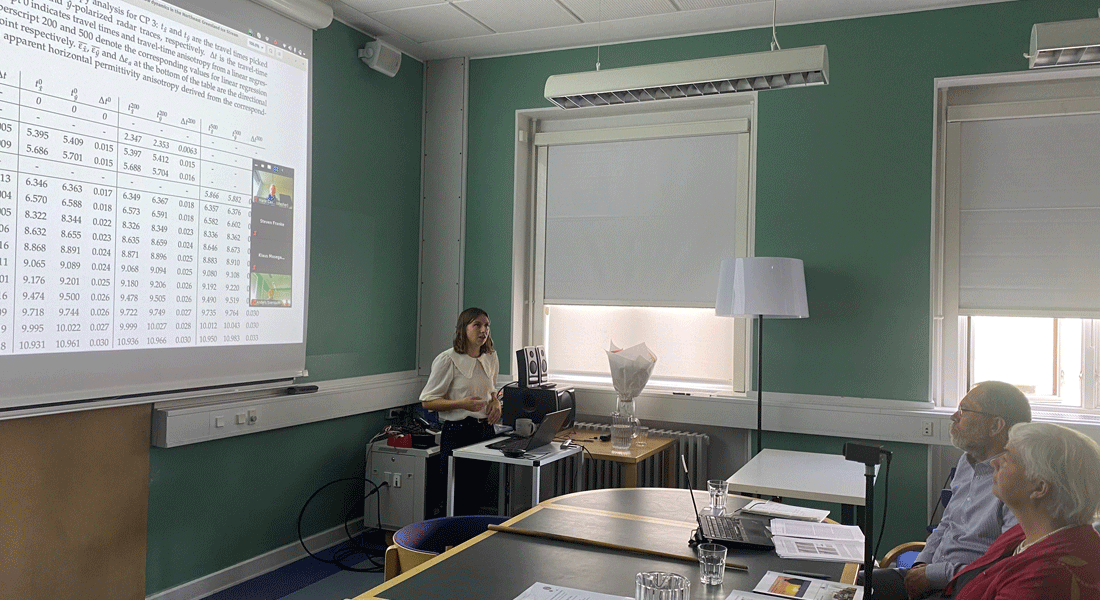Congratulations to Tamara Gerber
Congratulations to Tamara Gerber at Physics of Ice, Climate and Earth who successfully defended her PhD thesis 15th of September, and obtained the degree of Doctor of Philosophy.

Title: Ice flow signatures on small and big scales
Combining radio-echo sounding and ice core data to characterize the flow dynamics in the Northeast Greenland Ice Stream
Abstract:
Ice streams transport large amounts of ice from the ice sheet interior to the coast and are responsible for the primary dynamic mass loss in Greenland and Antarctica. The future stability of ice sheets and their contribution to sea-level rise strongly depends on the response of ice streams to a warming climate. Yet, the physical processes that govern rapid ice flow are still not entirely understood, and prognostic ice-sheet models cannot accurately reproduce these highly dynamic areas. The Northeast Greenland Ice Stream (NEGIS) is Greenland’s largest active ice stream and extends from the ice-sheet center over more than 700 km to the northeastern coast. A deep ice core, the East Greenland Ice-core Project (EastGRIP), is drilled in its onset region and can provide unique, detailed information about past climatic conditions and ice-flow history, as well as the physical properties affecting present-day ice flow. However, observations from ice cores at single point locations might not be representative of the conditions over broader spatial scales, and climatic interpretations in fast-flowing areas are therefore affected by upstream flow effects. Radio-echo-sounding (RES) can provide complementing information on larger spatial scales through the efficient mapping of in-situ properties of ice sheets using electromagnetic waves. However, an unambiguous interpretation of radargrams is difficult without additional information on the physical properties of the subsurface.
This thesis aims to combine the information from the EastGRIP ice core with an extensive set of RES images recorded in the NEGIS onset region in order to link the small scales of direct observations with the larger scales required for ice flow models and a complete understanding of ice stream dynamics. My studies specifically focus on the internal stratigraphy that causes radar reflections due to contrasts in dielectric properties. By simulating the movement of internal layers with a simple ice-flow model, I determined the upstream flow effects affecting some of the chemical properties measured in the EastGRIP ice core. Travel time differences in the signal reflections between different antenna polarizations further provide information about the ice crystal orientation fabric. In combination with other methods, this approach allowed me to obtain a map of the spatial distribution of the crystal fabric anisotropy, as well as determining its potential effects on the ice viscosity and hence flow dynamics. Finally, I investigated the reflection properties of the internal stratigraphy near EastGRIP by numerical modeling of synthetic radargrams with the dielectric record of the EastGRIP ice core, allowing me to study the effects of small-scale folds and layer roughness on the received signal.
The results obtained in this thesis thus have wide implications for reducing ambiguities in the interpretation of radargrams and ice core measurements, thereby hoping to contribute towards an improved and more holistic understanding of the dynamic processes governing the NEGIS.
Supervisors: Dorthe Dahl-Jensen, Sune Olander Rasmussen
Evaluation Committee: Anders Svensson (chair), Knut Christianson, Marie Cavitte
